
Wine Culture and Information since 2002 - Volume 22
 Wine Culture and Information since 2002 - Volume 22 |
|
Issue 132, September 2014 |
Contents |
|
|
What About Sweets? |
|
Everyone has his or her own tastes, and this also includes wine, and this is, of course, normal and desirable. Preferences for the many styles of wines - like already said in the past - continuously change over time, also being unavoidably affected by fads, social and cultural trends. Whites, reds, sparkling, roses and sweets, all of them had their moments of glory as well as moments of lesser splendor. Cycles repeating over time and today, it seems like so, the interest of consumers is mainly for red wines despite whites are trying to catch the favor of wine lovers back. Even sparkling and rose wines - despite in a lesser extent - have taken their revenge, not as strong as the one of whites and reds, but in certain moments they proved to be pretty good contenders, in particular bubbles. The ones evidently having a very hard time in getting the favor of consumers are sweet wines. I admit I have pretty particular preferences and tastes - including about wine - and sometimes I am in counter-tendency to fads and the trends of the moment, nevertheless I have always had an endless passion for sweet and fortified wines. I do not think I am a sort of paladin, taking up the cause of the weaker - sweet wines, in this case - I simply believe these nectars, a word I find to be absolutely appropriate in this case, represent the apotheosis of sensorial emotions. Endless symphonies of aromas and flavors, it would in fact be limited and banal to consider these wines for their simple and superficial quality represented by sweetness. Their production and the use of dried grapes give in fact these wines extraordinary and complex sensorial qualities, something very hard - if not impossible - to perceive in any other style of wine. Sweet wines, including fortified ones, are enological monuments, heritage of a very long tradition man has realized with vine and grape. We may also think the current taste of people is not interested in sweetness, nevertheless the consumption of sweet foods is very high. Sugar, in all of its endless forms, is virtually found in every food, also added to those in which we would not expect to find it. If we simply read the labels of many commercial foods and beverages, we can easily spot the presence of sugar, in its many forms, it is virtually found everywhere. It seems humans love sweetness and they do appreciate it even in the so called salty foods: our diet is invaded by sugar. According to this logic, sweet wine would seem to be considered among the most preferred ones: on the contrary, sweet and fortified wines - by using producers' words - are very hard to sell. The production is among the most complex and critical ones, an effort which is not paid back by the market. It must be said, in fact, in past times sweet wines - quality sweet wines, of course - have literally made wine lovers dream, these nectars were usually found in the tables of the well-off and noble people. They therefore were expensive and looked for wines: characteristics they still have today in most of the cases. I asked myself many times whether price should be considered the main responsible for the scarce appreciation of these wines in consumers. This can certainly be one of the many factors, it can also be an important one, but I do not think it is the main one. People - talking in general terms - simply do not like them, sometimes they even admit these wines cannot meet their taste anyway. To put it in simple words, they do not like them. It can be because of their sweetness, something being - evidently - so distant and different from the masculine character of certain reds, frequently considered as the “real wine” by connoisseurs. It should be said not every sweet wine is a nectar worth of attention and respect. For the sake of truth, there are many sweet wines which cannot exactly be considered amazing, result of awkward and pale wine making attempts and of doubtful quality. The opposite is true as well, as there are many out there of monumental and magnificent quality. Extraordinary examples of noble and impeccable elegance, inexorably humiliated by the market. The same is true for fortified wines, a style I endlessly love just like sweet wines. Maybe it is because they are usually made from dried grapes, giving to some the idea of dead grape, indeed these wines have a lively and indispensable crispness, making them absolutely alive. Wine of huge complexity - from appearance to taste - their life is in continuous evolution, a sort of challenge with time, during which they get better and richer. The great and unforgettable Gino Veronelli - the great Italian wine writer - invented a term capable of fully describing the sumptuousness and magnificence of these nectars, by calling them “meditation wines”. A term he used not only for sweet wines but it let everyone understand these wines required a lot of attention in order to be understood and enjoyed, while giving back endless emotional and sensorial satisfaction. It could then be a matter of superficiality. Consumers can be easily charmed by the appearance and immediate simplicity of certain wines, while considering too much demanding listening to the glass, not only at an emotional level, but also analytically, critically and consciously. Maybe we all are too busy in chasing our superficial frenzy, while forgetting that, sometimes, slowness is a great master of life giving us a better awareness of ourselves and of the world. In this superficial social logic, it may be complex and complicated sweet and fortified wines do not have their place anymore, as we are probably looking for our satisfaction in the simple and not demanding immediateness. Everything, all at once and easily, without the effort of thinking about it so much. Whatever will be, will be: I however keep on meditating in the beauty of my beloved sweet and fortified wines. Antonello Biancalana
|
||||
The Many Faces of Pinot NoirThe great grape from Burgundy, famous in the world for the elegance of its wines, is an extremely versatile variety, capable of successfully making every style of wine |
|
White, rose, sparkling and red. It is not so difficult to find these style of wines made from Pinot Noir. Even sweet, although there are very few and rare examples of wines produced with dried Pinot Noir, this famous variety from Burgundy shows its elegance also in this particular style. From a purely theoretical point of view, every red berried grape can be used for the production of every wine style. By just considering theory, all the red grapes in fact have sugar, acidic and polyphenolic substances, each of them being fundamental for the production of every wine style. From this point of view, this purely theoretical condition is easily denied by practice, as not all the red grapes have such a high versatility. All of them, undeniably, can be used for the production of red wines, but only few of them can successfully make other wine styles, enologically speaking. Each element, fundamental for the production of each wine style, is variable both in quantity and quality in function of ripeness and the specific variety. In particular, the availability and the ratio between acidic substances and sugar is strongly determined by the period of ripeness. In unripe grapes, acidic substances prevail over sugar, a condition becoming the opposite as the grape ripens. The riper the grape, the higher the quantity of sugar and lower the quantity of acidic substances. An evolution having its limit in the specific qualities of a grape, as not all the varieties have the same quantity of sugar and acidic substances. For example, Pinot Noir has a higher content in acidic substances than Merlot which, in turn, has a higher quantity of polyphenolic substances. The quality of polyphenolic substances - mainly responsible, among the many things, for color and astringency in red wines - can change according to the variety of grape and ripeness. Not all the grapes have in fact the same quantity of polyphenolic substances and also the intensity of astringency and color can change in function of the variety. The astringent sensation of polyphenolic substances - like already said - also changes according to the ripeness of the grape: harsher and more astringent when the grape is unripe, rounder and gentle at full ripeness. It should also be noticed that, from a theoretical point of view, the presence of polyphenolic substances can be strongly reduced - or even eliminated - by separating the skin from the must soon after crushing. In case we are not going to correct the must and wine with proper and legal procedures, the wine making versatility is therefore limited to the specific characteristics of each grape variety. The enological success of a grape variety in function of the style is mainly determined by the sensorial balance of the wines it produces. A result which is obtained by the contrast of the so called round and hard substances to which is added, in red wines, the contribution of polyphenols' astringency. We should remind round substances of a wine are represented by alcohol, polyalcohols and sugar. Hard substances of a wine are represented by acids, polyphenols and mineral salts. The balance in white wines can be simply defined as the opposition of round and hard substances, ideally set in opposite sides, each of them trying to move the balance point to its side. The balance of sparkling wine is substantially defined like that, while noticing to the hard substances is also added carbon dioxide, responsible of wine effervescence.
The definition of balance in rose wines is not so different from this model, whereas for red wines it is preferred applying a different model. The discriminating factor is represented by polyphenolic substances, despite they are considered as hard, it is preferred to consider them as a special case. In red wines we will therefore have a balance model defined by three sides, putting the astringency in a specific one. The need for such a model depends on the strengthening and mutual effect polyphenolic and acidic substances play on the other ones. Acidity tends in fact to amplify the sensation of astringency which, on its turn, tends to amplify acidity. In this sense, even carbon dioxide plays a similar role in amplifying the sensations of these two substances. By following these models of balance, it is evident how a red wine cannot be both acidic and astringent, as it would clearly be unbalanced in favor of “hard” substances and they would mutually amplify one each other. This condition can be balanced by increasing round substances, alcohol and polyalcohols in dry wines, sugar in sweet ones. This is in fact the case of wines produced with Nebbiolo - a grape known for being rich in polyphenolic and acidid substances - which are usually characterized by a high alcohol content and the aging in wood contributes to their roundness. Time plays a role in balance as well, in particular in the aggressive effect of polyphenolic substances, making them rounder and less harsh, a condition lowering the sensation of hardness in a wine. Finally, it should also be noticed the presence of residual sugars - a condition which can also happen in table wines - contributes to the lowering of strength of hard substances. The case of Pinot Noir is pretty special as the quality and quantity of the substances contained in its berries make them particularly versatile. The main factors of this versatility are the high content in acidic substances and the relatively low quantity of polyphenolic substances. When used for the production of red wines - the style that, at least in theory, should be the most obvious one - Pinot Noir is characterized by an elegant acidity and moderate astringency, two very appreciated characteristics to the ones who love this grape. Moreover, it is right this particular condition, as well as its characteristic aromas, to thrill Pinot Noir lovers by recognizing to it an unequaled class and elegance. For the sake of truth, this is the very same reason making it insignificant to many other wine lovers, usually the ones looking for strong emotions. Acidity in Pinot Noir is fundamental for the production of white and sparkling wines. In white wines produced with red grapes, such as Pinot Noir, the coloring of the must is avoided by removing skins soon after crushing, therefore preventing the contact. As it is commonly known, the color in red wines is determined by the maceration of the must with skins in which are found coloring substances. The fermentation done with skins contributes to the extraction of coloring substances because of the progressive increasing of alcohol and temperature. In white wines produced with Pinot Noir, balance is therefore obtained thanks to the presence of alcohol and acidic substances. Acidity, as it is commonly known, is a desired quality in white wines, on the contrary, its lack determines an excessive flatness and roundness. As opposed to many white berried grapes, Pinot Noir contributes to white wines with an evident structure. The characteristic structure Pinot Noir gives to its white wines is also important in sparkling wines. For example, we can consider two classic method sparkling wines, made by the same winery and possibly having the same period of aging in bottle. The first one produced with white berried grapes only, the second one produced with the same grapes to which is added Pinot Noir. In case we are considering a Champagne or Franciacorta, in the first wine we will have Chardonnay only, whereas in the second one, to this grape may have also been added Pinot Blanc. By tasting the wines, the contribution of Pinot Noir is evident and immediate: the second sparkling wine, in general terms, will be characterized by a fuller body and, very likely, a more intense color as well. It should also be noticed structure is also determined by the time of aging in bottle prior to disgorging and the contribution of yeasts. The considerations expressed for white wines are applied, in general terms, to rose wines as well. The particular production technique, providing for the contact of the must with the skin for few hours, gives rose wines produced with Pinot Noir pretty pale pink colors, rarely intense. It should also be considered sometimes the wines produced with this grape are obtained by using the bleeding technique and, in these cases, the color could get darker and more intense hues. Bleeding is the technique used for increasing the body and color in red wines, by subtracting part of the must soon after the starting of fermentation which, in that moment, has a pink color. In both cases, the contribution of polyphenolic substances is pretty limited. It will be the crispness and acidity of Pinot Noir to play an important role in its rose wines: a typical and desired characteristic both in rose and white wines. Sweet wines produced with Pinot Noir are to be considered as an absolute rarity and their spreading is very limited. One of the essential factors capable of giving sweet wines their balance is represented by acidity. A too sweet wine would be, in fact, not very pleasing and evidently sickly. In this sense, the evident acidity of Pinot Noir is very effective in balancing the sweetness in these type of wines. If we consider, in fact, the low contribution in astringency of Pinot Noir, sweetness finds its balance with acidity, while giving the wine an absolutely lively and elegant character. According to an olfactory point of view - as well as to the production technique - sweet wines produced with Pinot Noir get pleasing and lovely aromas of red fruit jams, such as cherry, strawberry and raspberry, in particular. A rare wine very difficult to find however capable of giving magnificent satisfactions to our senses. Pinot Noir, despite its undeniable wine making versatility, is mainly associated to what it is considered its most noble style: red wine. Loved or hated, Pinot Noir vinified in red has die-hard supporters as well as convinced detractors. It should be noticed not all of the Pinot Noir wines are capable of giving pleasing emotions, as - in order to give its best - this grape needs particular environmental and viticultural conditions. Known for being among the most difficult varieties to be cultivated - something which certainly is true - also in the winery Pinot Noir is a grape which does not accept compromises. This variety in fact needs the highest quality standards, an essential condition in order to make a great Pinot Noir. Finally, it should be noticed Pinot Noir cultivated in unfavorable areas and vinified with a scarce attention, always give a mediocre wine having no character, so different from the elegant and extraordinary greatness of this magnificent Burgundian grape.
|
||||||||||||
Wines of the Month |
|
|
|
Score legend Prices are to be considered as indicative. Prices may vary according to the country or the shop where wines are bought |
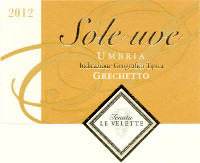
|
|
Sole Uve 2012 |
|
| Le Velette (Umbria, Italy) | |
| Grapes: Grechetto | |
| Price: € 12.00 | Score: |
| Sole Uve shows a brilliant golden yellow color and nuances of straw yellow, very transparent. The nose denotes intense, clean, pleasing and refined aromas which start with hints of apple, pear and plum followed by aroms of citrus fruits, hawthorn, broom, hazelnut, peach, honey and hints of vanilla. The mouth has good correspondence to the nose, a crisp attack and however balanced by alcohol, good body, intense flavors, pleasing roundness. The finish is persistent with flavors of plum, apple and pear. A part of Sole Uve ages in cask for about 4 months. | |
| Food Match: Pasta with fish, Stewed fish, Sauteed white meat | |
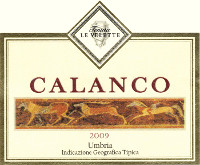
|
|
Calanco 2009 |
|
| Le Velette (Umbria, Italy) | |
| Grapes: Sangiovese (65%), Cabernet Sauvignon (35%) | |
| Price: € 18.00 | Score: |
| Calanco shows a deep ruby red color and nuances of garnet red, little transparency. The nose denotes intense, clean, pleasing and refined aromas which start with hints of plum, black currant and black cherry followed by aromas of violet, blueberry, blackberry, vanilla, cocoa, tobacco and eucalyptus. The mouth has good correspondence to the nose, a properly tannic attack and however balanced by alcohol, good body, intense flavors, agreeable. The finish is persistent with flavors of plum, black cherry and black currant. Calanco ages for 16 months in barrique followed by 14 months of aging in bottle. | |
| Food Match: Roasted meat, Stewed and braised meat, Hard cheese | |

|
|
Arquata Rosso 2007 |
|
| Adanti (Umbria, Italy) | |
| Grapes: Cabernet Sauvignon (40%), Merlot (40%), Barbera (20%) | |
| Price: € 18.00 | Score: |
| Arquata Rosso shows an intense ruby red color and nuances of garnet red, little transparency. The nose reveals intense, clean, pleasing, refined and elegant aromas which start with hints of black currant, plum and black cherry followed by aromas of blueberry, violet, vanilla, cocoa, tobacco, cinnamon, mace, leather and eucalyptus. The mouth has good correspondence to the nose, a tannic attack and however balanced by alcohol, full body, intense flavors, pleasing roundness. The finish is persistent with flavors of black currant, plum and black cherry. Arquata Rosso ages in barrique for 2 years followed by 6 months of aging in bottle. | |
| Food Match: Game, Roasted meat, Stewed and braised meat, Hard cheese | |
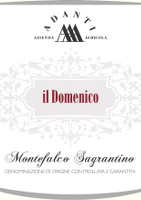
|
|
Sagrantino di Montefalco Il Domenico 2007 |
|
| Adanti (Umbria, Italy) | |
| Grapes: Sagrantino | |
| Price: € 35.00 | Score: |
| Sagrantino di Montefalco Il Domenico shows an intense ruby red color and nuances of garnet red, little transparency. The nose denotes intense, clean, pleasing, refined and elegant aromas that start with hints of blackberry, plum and dried violet followed by aromas of black cherry, blueberry, vanilla, cocoa, tobacco, licorice, graphite, mace, leather and menthol. The mouth has excellent correspondence to the nose, a tannic attack and however balanced by alcohol, full body, intense flavors, pleasing roundness. The finish is very persistent with long flavors of blackberry, plum and black cherry. Sagrantino di Montefalco Il Domenico ages for 30 months in cask followed by 24 months of aging in bottle. | |
| Food Match: Game, Roasted meat, Braised and stewed meat, Hard cheese | |

|
|
Brunello di Montalcino 2009 |
|
| Altesino (Tuscany, Italy) | |
| Grapes: Sangiovese | |
| Price: € 35.00 | Score: |
| This Brunello di Montalcino shows a brilliant ruby red color and nuances of garnet red, moderate transparency. The nose denotes intense, clean, pleasing, refined and elegant that start with hints of black cherry, plum and violet followed by aromas of blueberry, vanilla, tobacco, raspberry, chocolate, mace, cinnamon and menthol. The mouth has good correspondence to the nose, a tannic attack and however balanced by alcohol, full body, intense flavors, agreeable. The finish is persistent with flavors of black cherry, plum and raspberry. Thish Brunello di Montalcino ages for at least 2 years in cask followed by 4 months of aging in bottle. | |
| Food Match: Game, Roasted meat, Stewed and braised meat, Hard cheese | |
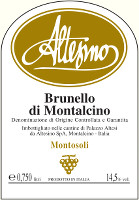
|
|
Brunello di Montalcino Montosoli 2009 |
|
| Altesino (Tuscany, Italy) | |
| Grapes: Sangiovese | |
| Price: € 65.00 | Score: |
| Brunello di Montalcino Montosoli shows a brilliant ruby red color and nuances of garnet red, moderate transparency. The nose reveals intense, clean, pleasing, refined and elegant aromas which start with hints of plum, raspberry and black cherry followed by aromas of violet, blackberry, blueberry, vanilla, cinnamon, chocolate, mace, pink pepper, tobacco and menthol. The mouth has excellent correspondence to the nose, a tannic attack and however balanced by alcohol, full body, intense flavors, agreeable. The finish is very persistent with long flavors of plum, raspberry and black cherry. Brunello di Montalcino Montosoli ages for 4 years in cask, 4 months in barrique and 4 months in bottle. | |
| Food Match: Game, Roasted meat, Stewed and braised meat, Hard cheese | |

|
|
Amarone della Valpolicella 2009 |
|
| Tedeschi (Veneto, Italy) | |
| Grapes: Corvina (30%), Corvinone (30%), Rondinella (30%), Rossignola, Oseleta, Negrara, Dindarella (10%) | |
| Price: € 30.00 | Score: |
| This Amarone della Valpolicella shows a deep ruby red color and nuances of garnet red, little transparency. The nose denotes intense, clean, pleasing, refined and elegant aromas which start with hints of blackberry, plum and dried violet followed by aromas of black cherry, blueberry, tobacco, vanilla, chocolate, mace and menthol. The mouth has good correspondence to the nose, a tannic attack and however balanced by alcohol, full body, intense flavors, pleasing roundness. The finish is persistent with flavors of blackberry, plum and black cherry. This Amarone della Valpolicella ages for 3 years in cask followed by 6 months of aging in bottle. | |
| Food Match: Game, Stewed and braised meat, Roasted meat, Hard cheese | |
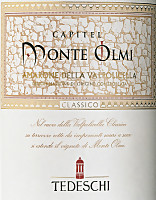
|
|
Amarone della Valpolicella Classico Capitel Monte Olmi 2008 |
|
| Tedeschi (Veneto, Italy) | |
| Grapes: Corvina (30%), Corvinone (30%), Rondinella (30%), Oseleta, Negrara, Dindarella, Croatina, Forselina (10%) | |
| Price: € 55.00 | Score: |
| Amarone della Valpolicella Classico Capitel Monte Olmi shows an intense ruby red color and nuances of garnet red, little transparency. The nose denotes intense, clean, pleasing, refined and elegant aromas which start with hints of blackberry, plum and dried violet followed by aromas of black cherry, blueberry, vanilla, tobacco, cocoa, cinnamon, green bean, licorice, leather and menthol. The mouth has excellent correspondence to the nose, a tannic attack and however balanced by alcohol, intense flavors, full body, pleasing roundness. The finish is very persistent with long flavors of blackberry, plum and black cherry. Amarone della Valpolicella Classico Capitel Monte Olmi ages for 4 years in cask followed by 6 months of aging in bottle. | |
| Food Match: Game, Stewed and braised meat, Roasted meat, Hard cheese | |

|
|
Vino Nobile di Montepulciano I Quadri 2010 |
|
| Bindella (Toscana, Italy) | |
| Grapes: Sangiovese | |
| Price: € 24.00 | Score: |
| Vino Nobile di Montepulciano I Quadri shows an intense ruby red color and nuances of ruby red, little transparency. The nose reveals intense, clean, pleasing, refined and elegant aromas which start with hints of black cherry, plum and violet followed by aromas of blueberry, raspberry, blackberry, vanilla, tobacco, chocolate, peony, cinnamon, pink pepper and menthol. The mouth has excellent correspondence to the nose, a tannic attack and however balanced by alcohol, full body, intense flavors, agreeable. The finish is very persistent with long flavors of black cherry, plum and blueberry. Vino Nobile di Montepulciano I Quadri ages for 18 months in cask followed by 6 months of aging in bottle. | |
| Food Match: Game, Stewed and braised meat, Roasted meat, Hard cheese | |

|
|
Vin Santo di Montepulciano Occhio di Pernice Dolce Sinfonia 2004 |
|
| Bindella (Toscana, Italy) | |
| Grapes: Sangiovese | |
| Price: € 45.00 - 375ml | Score: |
| Vin Santo di Montepulciano Occhio di Pernice Dolce Sinfonia shows a deep brick red color and nuances of amber yellow, little transparency. The nose reveals intense, clean, pleasing, refined and elegant aromas which start with hints of raisin, prune and caramel followed by aromas blackberry jam, black cherry jam, blueberry jam, chocolate, cinchona, cinnamon, tobacco, nutmeg, rhubarb, vanilla and nail polish. The mouth has excellent correspondence to the nose, a sweet and round attack, however balanced by alcohol, full body, intense flavors, pleasing crispness. The finish is very persistent with long flavors of raisin, prune and blackberry jam. Vin Santo di Montepulciano Occhio di Pernice Dolce Sinfoniaages for at least 6 years in small barrels followed by 12 months of aging in bottle. | |
| Food Match: Hard and piquant cheese, Dried fruit tarts, Chocolate tarts | |
News |
|
In this section are published news and information about events concerning the world of wine and food. Whoever is interested in publishing this kind of information can send us a mail to our address.
|
AquavitaeReview of Grappa, Distillates and Brandy |
|
|
| Distillates are rated according to DiWineTaste's evaluation method. Please see score legend in the "Wines of the Month" section. |

|
|
Gin |
|
| Nannoni (Tuscany, Italy) | |
| Raw matter: Alcohol, Juniper berries | |
| Price: € 35.00 - 50cl | Score: |
| This gin shows a brilliant amber yellow color, limpid and crystalline. The nose reveals intense, clean, pleasing and refined aromas of juniper, honey and hazelnut, with almost imperceptible alcohol pungency. In the mouth has intense flavors, with perceptible alcohol pungency which tends to dissolve rapidly, good correspondence to the nose, pleasing roundness. The finish is persistent with flavors of juniper and honey. This gin is produced by infusing juniper berries in wine alcohol. Product made by Distilleria Nannoni and commercialized with its own label by “Villa Liverzano”. | |
Wine Parade |
|
|
| The best 15 wines according to DiWineTaste's readers. To express your best three wines send us an E-mail or fill in the form available at our WEB site. |
| Rank | Wine, Producer | |
|---|---|---|
| 1 |
| Villa Gresti 2006, Tenuta San Leonardo |
| 2 |
| Amarone della Valpolicella Classico Capitel Monte Olmi 2007, Tedeschi |
| 3 |
| Brunello di Montalcino Vigna Loreto 2007, Mastrojanni |
| 4 |
| Sagrantino di Montefalco Collepiano 2007, Arnaldo Caprai |
| 5 |
| Langhe Riesling Herzu 2011, Ettore Germano |
| 6 |
| Pelago 2009, Umani Ronchi |
| 7 |
| Brunello di Montalcino 2007, Donatella Cinelli Colombini |
| 8 |
| Maximo 2010, Umani Ronchi |
| 9 |
| Verdicchio dei Castelli di Jesi Classico Superiore Podium 2010, Garofoli |
| 10 |
| Collio Ribolla Gialla L'Adelchi 2012, Venica |
| 11 |
| I Sodi di San Niccolò 2008, Castellare di Castellina |
| 12 |
| Camartina 2008, Querciabella |
| 13 |
| Adarmando 2011, Tabarrini |
| 14 |
| San Leonardo 2006, Tenuta San Leonardo |
| 15 |
| Montiano 2011, Falesco |
| |||||||
Privacy Policy | |||||||


| Copyright © 2002-2024 Antonello Biancalana, DiWineTaste - All rights reserved |
| All rights reserved under international copyright conventions. No part of this publication and of this WEB site may be
reproduced or utilized in any form or by any means, electronic or mechanical, without permission in writing from DiWineTaste. |